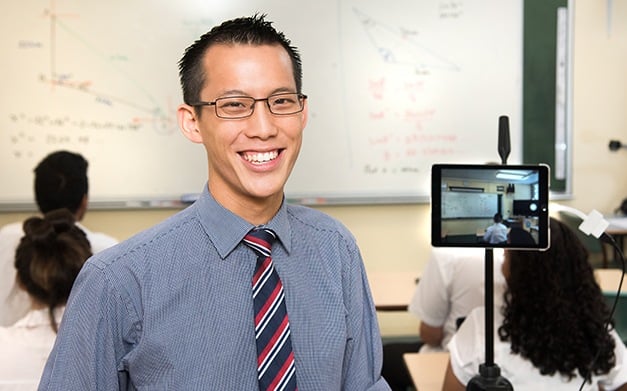
Schools Plus has been supporting schools, students and teachers through the pandemic to address the negative impacts of remote learning and other COVID disruptions on children’s learning and wellbeing.
As NSW and Victoria return to face-to-face learning this term, we asked our ambassador Eddie Woo – Australia’s favourite and award-winning maths teacher – to give his perspective.
Here’s Eddie’s advice to teachers and parents:
After this extended period of learning from home, many of us are understandably craving the return to school. However, part of the challenge of this global pandemic has been that so many of our experiences and daily realities are unprecedented. This means that we have few natural instincts for how to go about some of the tasks we need to perform, or that our first inclinations for how to bring our children back into classrooms may need to be adjusted in counter-intuitive ways. From my perspective as an educator and a parent of children in both primary and high school, here are some of my tips for how to manage this transition effectively.
Everyone needs bespoke support
Each child has had a unique experience of remote learning. Even within a family, siblings can vary wildly when it comes to how they navigated the self-directed environment of learning from home. While some thrive on being able to drive their own work schedule, others struggle to maintain any sense of motivation without their classroom’s social fabric and their teacher’s knowing guidance.
Similarly, each individual will have responded differently to the limitations of personal interaction during lockdown. This has major implications for how each student experiences the return to school and it’s vital that whatever steps we take, we acknowledge that one size will not fit all and we will need to take the time to understand each child’s specific needs. Recognising this also underscores the necessity of effective community collaboration: parents and teachers can support children most effectively when we use our perspectives together to build an accurate profile of what each child needs.
Wellbeing supersedes learning
There has never been a more important time for the voices of our children to be heard as we form new ways of functioning in school together. What are the things they are finding hardest to adjust to? Are there things they enjoyed about learning from home – such as flexibility and autonomy that came from some forms of remote learning – that we can retain in some form when we return to learning in person? We will not know the answers to any of these questions, let alone be able to craft helpful solutions to these challenges, without giving our children a seat at the table when we discuss and make decisions about how to move forward.
Valuing student voice and legitimacy begins with us, both as parents and teachers, seeking out the opinions of our children and listening closely. Students need to trust that their views will be listened to and honoured with responsive action. This begins by devoting serious time to these conversations and making sure they are not tokenistic exercises
Make time for talk
Over the last two years, especially in line with the drumbeat of high-stakes standardised assessments, much ink has been spilt in concern about “lost learning”: the suggestion that students will fall behind because they have had a disrupted educational experience. While it is true that students’ academic progression has been affected by the interruption of in-person learning, particularly from an equity standpoint (due to the varying levels of access to technology and other enablers for remote learning), it is unhelpful and unrealistic for students to return to school with the expectation that learning will accelerate in order to catch up to the expectations of a normal academic year. While this may be worth working toward, a child’s psychological and social needs must be attended to first.
Educators have a shorthand way for articulating this order of importance: we say, Maslow’s before Bloom’s. It’s a reference to Maslow’s hierarchy of needs (physiological, safety, social, esteem, self-actualisation), which supersedes Bloom’s taxonomy of learning objectives (knowledge, comprehension, application, analysis, synthesis, evaluation). As we return to schools, we must ensure that we retain this focus and recognise that a child cannot be expected to make any academic progress until their wellbeing needs are met.